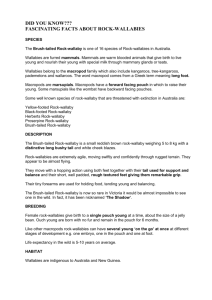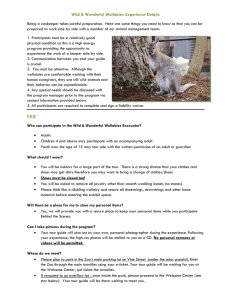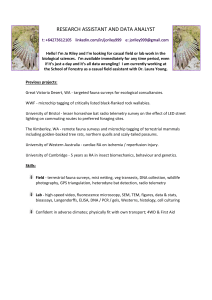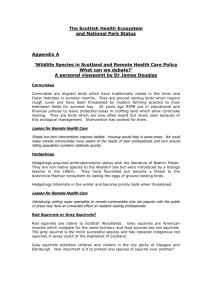SHORT COMMUNICATION Macropus eugenii
advertisement
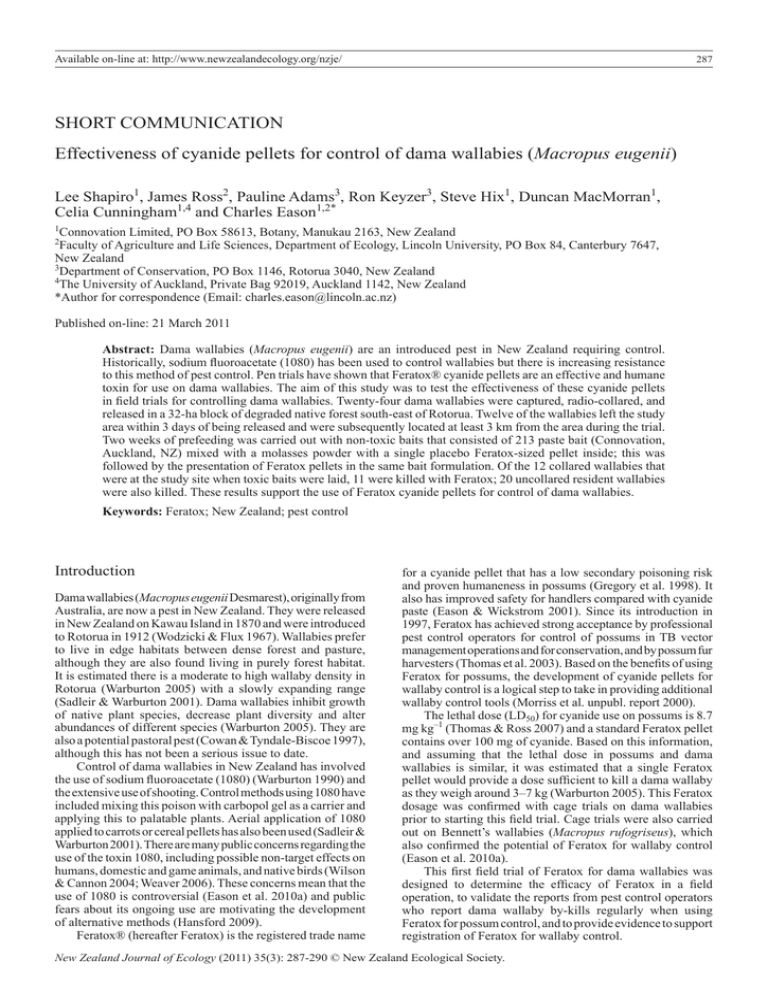
Shapiro eton-line al.: Cyanide effectiveness in dama wallabies Available at: http://www.newzealandecology.org/nzje/ 287 SHORT COMMUNICATION Effectiveness of cyanide pellets for control of dama wallabies (Macropus eugenii) Lee Shapiro1, James Ross2, Pauline Adams3, Ron Keyzer3, Steve Hix1, Duncan MacMorran1, Celia Cunningham1,4 and Charles Eason1,2* 1 Connovation Limited, PO Box 58613, Botany, Manukau 2163, New Zealand Faculty of Agriculture and Life Sciences, Department of Ecology, Lincoln University, PO Box 84, Canterbury 7647, New Zealand 3 Department of Conservation, PO Box 1146, Rotorua 3040, New Zealand 4 The University of Auckland, Private Bag 92019, Auckland 1142, New Zealand *Author for correspondence (Email: charles.eason@lincoln.ac.nz) 2 Published on-line: 21 March 2011 Abstract: Dama wallabies (Macropus eugenii) are an introduced pest in New Zealand requiring control. Historically, sodium fluoroacetate (1080) has been used to control wallabies but there is increasing resistance to this method of pest control. Pen trials have shown that Feratox® cyanide pellets are an effective and humane toxin for use on dama wallabies. The aim of this study was to test the effectiveness of these cyanide pellets in field trials for controlling dama wallabies. Twenty-four dama wallabies were captured, radio-collared, and released in a 32-ha block of degraded native forest south-east of Rotorua. Twelve of the wallabies left the study area within 3 days of being released and were subsequently located at least 3 km from the area during the trial. Two weeks of prefeeding was carried out with non-toxic baits that consisted of 213 paste bait (Connovation, Auckland, NZ) mixed with a molasses powder with a single placebo Feratox-sized pellet inside; this was followed by the presentation of Feratox pellets in the same bait formulation. Of the 12 collared wallabies that were at the study site when toxic baits were laid, 11 were killed with Feratox; 20 uncollared resident wallabies were also killed. These results support the use of Feratox cyanide pellets for control of dama wallabies. Keywords: Feratox; New Zealand; pest control Introduction Dama wallabies (Macropus eugenii Desmarest), originally from Australia, are now a pest in New Zealand. They were released in New Zealand on Kawau Island in 1870 and were introduced to Rotorua in 1912 (Wodzicki & Flux 1967). Wallabies prefer to live in edge habitats between dense forest and pasture, although they are also found living in purely forest habitat. It is estimated there is a moderate to high wallaby density in Rotorua (Warburton 2005) with a slowly expanding range (Sadleir & Warburton 2001). Dama wallabies inhibit growth of native plant species, decrease plant diversity and alter abundances of different species (Warburton 2005). They are also a potential pastoral pest (Cowan & Tyndale-Biscoe 1997), although this has not been a serious issue to date. Control of dama wallabies in New Zealand has involved the use of sodium fluoroacetate (1080) (Warburton 1990) and the extensive use of shooting. Control methods using 1080 have included mixing this poison with carbopol gel as a carrier and applying this to palatable plants. Aerial application of 1080 applied to carrots or cereal pellets has also been used (Sadleir & Warburton 2001). There are many public concerns regarding the use of the toxin 1080, including possible non-target effects on humans, domestic and game animals, and native birds (Wilson & Cannon 2004; Weaver 2006). These concerns mean that the use of 1080 is controversial (Eason et al. 2010a) and public fears about its ongoing use are motivating the development of alternative methods (Hansford 2009). Feratox® (hereafter Feratox) is the registered trade name for a cyanide pellet that has a low secondary poisoning risk and proven humaneness in possums (Gregory et al. 1998). It also has improved safety for handlers compared with cyanide paste (Eason & Wickstrom 2001). Since its introduction in 1997, Feratox has achieved strong acceptance by professional pest control operators for control of possums in TB vector management operations and for conservation, and by possum fur harvesters (Thomas et al. 2003). Based on the benefits of using Feratox for possums, the development of cyanide pellets for wallaby control is a logical step to take in providing additional wallaby control tools (Morriss et al. unpubl. report 2000). The lethal dose (LD50) for cyanide use on possums is 8.7 mg kg–1 (Thomas & Ross 2007) and a standard Feratox pellet contains over 100 mg of cyanide. Based on this information, and assuming that the lethal dose in possums and dama wallabies is similar, it was estimated that a single Feratox pellet would provide a dose sufficient to kill a dama wallaby as they weigh around 3–7 kg (Warburton 2005). This Feratox dosage was confirmed with cage trials on dama wallabies prior to starting this field trial. Cage trials were also carried out on Bennett’s wallabies (Macropus rufogriseus), which also confirmed the potential of Feratox for wallaby control (Eason et al. 2010a). This first field trial of Feratox for dama wallabies was designed to determine the efficacy of Feratox in a field operation, to validate the reports from pest control operators who report dama wallaby by-kills regularly when using Feratox for possum control, and to provide evidence to support registration of Feratox for wallaby control. New Zealand Journal of Ecology (2011) 35(3): 287-290 © New Zealand Ecological Society. 288 Materials and methods The trial site was a 32-ha block of degraded native forest surrounded by farmland at Waikite, 20 km south-east of Rotorua (38°17’34’’ S, 176°19’51” E). The land is managed by the Department of Conservation through an open space covenant. Monitoring of dama wallabies was originally intended to be carried out following the standard wallaby night count protocol published by the National Possum Control Agencies (NPCA 2007) prior to the trial and again at the conclusion of the trial to enable the percentage kill of wallabies from the trial to be determined. Night counts were carried out on a single night prior to the trial and involved walking transects with a spotlight and recording all wallabies seen. Two observers walked five transects, each 100 m, randomly selected on a map of the site prior to the counts. In total, 14 wallabies were sighted. Several experimental concerns arose regarding the suitability of this monitoring technique; firstly, this method generally uses transects of at least 10 km in length and our study area was only 32 ha. Secondly, when we did carry out pre-control monitoring following this protocol only 0.33 wallabies per kilometre were observed and, as has been observed with hares, this is too low for any robust analysis (Parkes 2001). Because of the unsuitable nature of this monitoring technique for a trial of this nature and the low number of wallabies observed, the research team decided to live-capture and radio-collar wallabies from a high density population at Craters Farm, Rotorua, and release them at the study site. Animal capture Wallabies were live-captured using pitfall traps and on removal they were placed in individual hessian bags to enable the attachment of transmitters. Collars were standard cat radio collars with an external whip aerial and were made by Sirtrack NZ (Havelock North, New Zealand). Collars had a pulse rate of 40 pulses per minute and all were mortality enabled so that after 12 h of no movement the pulse rate switched to 80 pulses per minute. Wallabies were tracked using a Telonics (TR4) receiver and a three-element Yagi aerial. Wallabies were transported from their point of capture in a transport container that conformed to the International Air Transport Association standards for transporting wallaby species. These animals were relocated to the study site and were weighed and sexed before being released together in a clearing on the eastern edge of the study site. Bait station layout A grid of 43 modified Philproof™ bait stations (Philproof Pest Control Products, Hamilton, NZ) was set out at the study site with approximately 100 m between each station. Bait stations were modified by sawing off the front hood to provide an opening 12 × 7 cm. Bait stations were attached to trees with a distance of 25 cm between the ground and the bottom of the station. The trial took place in summer from December 2008 to January 2009; there were no unusual weather conditions. Possum and rodent control Possum and rodent control was carried out before the trial commenced, to reduce the amount of potential bait interference from non-target species. Possum trappers set leg-hold traps over a period of a week and Feracol® (active ingredient cholecalciferol at a concentration of 8 g kg–1, Connovation, Auckland, NZ) was used in small potato starch bait stations New Zealand Journal of Ecology, Vol. 35, No. 3, 2011 called ‘Strikers’ (12 g, Connovation, Auckland, NZ). The ‘Strikers’ were stapled at least 1.5 m above ground at each bait station site, thereby excluding wallabies, and were removed before the trial commenced. RatAbate® (active ingredient diphacinone at a concentration of 0.05 g kg–1; Connovation, Auckland, NZ) was placed in tunnels, to target rodents. These tunnels excluded wallabies and other non-target species. These bait stations remained present throughout the trial. The continued presence of possums and rodents at the site throughout the trial, based on possum and rodent field sign and rodent prints on ink cards in the tunnel bait stations, made it difficult to accurately assess the timing and amount of nontoxic and toxic bait take by dama wallabies. Non-toxic and toxic stages Each bait station was loaded with 10 non-toxic baits. These baits were a ball (10 mm in diameter) consisting of a mix of 213 paste (commercial possum paste, Connovation, Auckland, NZ) and Palabind molasses powder (commercial horse feed, distributed by Pro-biotic) and contained a single placebo Feratox-sized pellet. Bait stations were loaded with non-toxic baits on three occasions with a period of 6 days between each occasion; bait stations were first loaded with non-toxic baits the day after collared wallabies were released. After the final six days of non-toxic baiting, all bait stations were cleared of non-toxic baits and replaced with 10 toxic baits. These baits consisted of a ball of 213 paste and Palabind mix, 10 mm in diameter, and a single Feratox pellet (110–120 mg KCN). For the first 13 nights, the stations were checked every day and baits were replenished to keep the number at 10 per station. Following this period, the study site was baited once more and checked 4 nights later. Wallabies were radio-tracked on foot each day following their release at the trial site, prior to the application of Feratox in the toxic stage of the trial. All collared wallabies were radiotracked twice during the toxic stage of the trial and once after all the Feratox pellets were removed from the site. As not all the wallabies remained in the trial site for the duration of the trial, collared wallabies were radio-tracked from a fixed-wing aircraft one week after the trial. This enabled us to locate their position in relation to the trial site and to check the mortality function on their transmitters. Whenever wallabies were found dead, the location was recorded using a GPS receiver and their distance from the nearest bait station calculated. Animal welfare This trial was carried out with approval from the New Zealand Food Safety Authority (V9534). All animal manipulations were approved by the Department of Conservation Animal Ethics Committee (approval no. 173) and were performed by a trained member of the Wallaby Management Team. Results Of the 24 radio-collared dama wallabies included in this trial, 12 were not located in the trial site when radio-tracked on foot over the first three days after release, and were also absent from the site during the non-toxic and toxic phases of the trial. A week after the conclusion of the trial, the use of radio telemetry from a fixed-wing aircraft located all 12 of these wallabies 3–8 km from the trial site. Of the 12 radio-collared wallabies that remained in the area Shapiro et al.: Cyanide effectiveness in dama wallabies 289 where Feratox pellets were dispensed, 11 (91.6%) (binomial 95% CI for kill of 61.5–99.8%) were killed with Feratox over the baiting period (Table 1). Their carcasses were found on average 2.17 m from the nearest bait station. Twenty uncollared wallabies resident in the block were also killed with Feratox; these consisted of 12 females (average weight 3.87 kg) and eight males (average weight 5.99 kg). Their carcasses were found on average 2.2 m from the nearest bait station. Numerous collared and uncollared wallabies were found directly under bait stations. Over half of the collared and uncollared wallabies killed over the toxic phase of the trial consumed baits and died in the first five nights of baiting (Fig. 1). Table 1. Key information from individual collared dama wallabies released at the Feratox® trial site. __________________________________________________________________________________________________________________________________________________________________ Wallaby Transmitter Sex Weight Last detected in trial area Fate 1 2 3 4 5 6 7 8 9 10 11 12 13 14 15 16 17 18 19 20 21 22 23 24 00 10 14 22 24 36 38 40 42 44 46 26 02 04 06 12 16 18 20 28 30 32 34 48 M M F M M F M F M F M F F M F F M F F M F F F F 5.86 4.56 1.66 3.81 5.25 4.12 6.30 4.67 2.98 2.91 6.29 4.46 4.36 4.16 4.76 3.81 5.01 4.37 4.63 6.30 4.36 5.16 3.88 4.87 Day 1 of toxic Day 8 of toxic Day 14 of toxic Day 2 of toxic Day 14 of toxic Day 1 of toxic Day 3 of toxic Day 5 of toxic Day 13 of toxic Day 14 of toxic Day 6 of toxic After trial finished Day 1 after release Day 2 after release Day 2 after release Day 1 after release Day 2 after release Day 2 after release Day 1 after release Day 2 after release Day 2 after release Day 3 after release Day 3 after release Day 2 after release Killed with Feratox Killed with Feratox Killed with Feratox Killed with Feratox Killed with Feratox Killed with Feratox Killed with Feratox Killed with Feratox Killed with Feratox Killed with Feratox Killed with Feratox Alive in the trial area Alive outside the trial area Alive outside the trial area Alive outside the trial area Alive outside the trial area Alive outside the trial area Alive outside the trial area Alive outside the trial area Alive outside the trial area Alive outside the trial area Alive outside the trial area Alive outside the trial area Alive outside the trial area __________________________________________________________________________________________________________________________________________________________________ __________________________________________________________________________________________________________________________________________________________________ 100 90 80 70 % Cumulative wallaby mortality 60 50 40 30 Uncollared wallabies 20 Collared wallabies 10 0 0 2 4 6 8 10 12 14 16 18 Nights Figure 1. Cumulative percentage of wallabies poisoned during the Feratox® baiting period. The cumulative percentage of uncollared wallabies is only for the 20 that were found. Mortalities for nights 14–16 are averages (See Methods). 290 Discussion The trial achieved more than 90% mortality of radio-collared wallabies that remained at the bait site. We were unable to calculate a reliable percentage mortality of the resident population because of the monitoring protocol being unsuitable for this site. The unsuitable nature of this monitoring protocol was further illustrated by the number of resident wallabies killed being much higher than that detected from spotlight counts carried out prior to the trial. The toxic stage of the trial took 17 days to achieve the 90% reduction in the radio-collared population. The trial was conducted over summer and it is possible that the population reduction time would have been shorter in winter when there would be less food competing with the bait for the wallabies’ attention. The first recorded bait take during the non-toxic phase of the trial was on the second night after baits were laid; the presence of possums and rats at the site meant we were unable to determine when the first baits were taken by wallabies. The results from this trial combined with pen data (Eason et al. 2010a) and recent field trials on Bennett’s wallabies in South Canterbury (Ross et al. 2010) shows Feratox to be both humane and effective for wallaby control. With the support of these data, product licence approval was given in August 2009 for the use of Feratox for dama wallaby control. An extension to the current Feratox registration to include Bennett’s wallaby is currently being sought. Control of Bennett’s wallaby is also required in Tasmania, Australia, to control an overabundance of this species (Eason et al. 2010b). Acknowledgements The support of Connovation, owner of the registered trademark for Feratox®, is acknowledged for supply of materials for the field trial. Staff at the Department of Conservation, Environment Bay of Plenty and Environment Waikato are thanked for their role as part of the research team. The study was funded by the Department of Conservation. References Cowan PE, Tyndale-Biscoe CH 1997. Australian and New Zealand mammal species considered to be pests or problems. Reproduction, Fertility and Development 9: 27–36. Eason CT, Wickstrom M 2001. Vertebrate pesticide toxicology manual (poisons). 2nd edn. Department of Conservation Technical Series 23. Wellington, Department of Conservation. 122 p. Eason CT, Miller A, Ogilvie S, Fairweather A 2010a. Updated review of the toxicology and ecotoxicology of sodium fluoroacetate in relation to its use as a pest control tool in New Zealand. New Zealand Journal of Ecology 35(1). Eason CT, Shapiro L, Adams P, Hix S, Cunningham C, MacMorran D, Statham M, Statham H. 2010b. Advancing a humane alternative to sodium fluoroacetate (1080) for wildlife management – welfare and wallaby control. Wildlife Research 37: 497–503. Gregory NG, Milne LM, Rhodes AT, Littin KE, Wickstrom M, Eason CT 1998. Effect of potassium cyanide on behaviour New Zealand Journal of Ecology, Vol. 35, No. 3, 2011 and time to death in possums. New Zealand Veterinary Journal 46: 60–64. Hansford D 2009. 1080. New Zealand Geographic 97: 52–63. NPCA 2007. Code A9: Pest wallabies: Control and monitoring of pest dama and Bennett’s wallabies. Best practice guideline. Wellington, National Possum Control Agencies. 21 p. Parkes J 2001. Methods to monitor the density and impact of hares (Lepus europaeus) in grassland in New Zealand. DOC Science Internal Series 8. Wellington, Department of Conservation. 13 p. Ross J, Hix S, Guilford G, Thompson S, Shapiro L, MacMorran D, Eason CT 2010. Effectiveness of cyanide pellets for control of Bennett’s wallaby (Macropus rufogrisea rufogrisea) in New Zealand. New Zealand Journal of Zoology: in press. Sadleir RMF, Warburton B 2001. Advances in New Zealand mammalogy 1990–2000: wallabies. Journal of the Royal Society of New Zealand 31: 7–14. Thomas M, Ross P 2007. Breakdown of cyanide and cholecalciferol in Feratox and Feracol possum baits. DOC Research & Development Series 288. Wellington, Department of Conservation. 28 p. Thomas MD, Maddigan FW, Brown JA, Trotter M 2003. Optimising possum control using encapsulated cyanide (Feratox®). New Zealand Plant Protection 56: 77–80. Warburton B 1990. Control of Bennett’s and tammar wallabies in New Zealand using compound 1080 gel on foliage baits. Australian Wildlife Research 17: 541–546. Warburton B 2005. Dama wallaby. In: King CM ed. The handbook of New Zealand mammals. 2nd edn. Melbourne, Oxford University Press. Pp. 32–39. Weaver SA 2006. Chronic toxicity of 1080 and its implications for conservation management: a New Zealand case study. Journal of Agricultural & Environmental Ethics 19: 367–389. Wilson CH, Cannon J 2004. Community consultation processes for aerial 1080 applications. Science for Conservation 247. Wellington, Department of Conservation. 52 p. Wodzicki K, Flux JEC 1967. Guide to introduced wallabies in New Zealand. Tuatara 15: 47–60. Editorial Board member: Kay Clapperton Received 4 February 2010; accepted 22 October 2010

